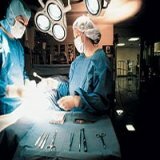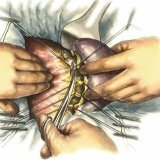Surgical treatment of peptic ulcer
 Peptic ulcer of the stomach and duodenum - the melancholy of the young generation of the 21st century. According to world statistics, gastric ulcer is spread around 10% of the adult population of the globe. Recently, there has been a significant increase in the disease, over the past 10 years it has amounted to about 38%, which is an awesome indicator for human health. Doctors all over the world are sounding the alarm and constantly talking about the need to prevent this ailment, and this is, first of all, a healthy diet, the absence of stressful situations and the exclusion of nicotine and alcohol.
Peptic ulcer of the stomach and duodenum - the melancholy of the young generation of the 21st century. According to world statistics, gastric ulcer is spread around 10% of the adult population of the globe. Recently, there has been a significant increase in the disease, over the past 10 years it has amounted to about 38%, which is an awesome indicator for human health. Doctors all over the world are sounding the alarm and constantly talking about the need to prevent this ailment, and this is, first of all, a healthy diet, the absence of stressful situations and the exclusion of nicotine and alcohol.
Modern medicine has learned to fight this disease well, such diseases of the digestive system as a stomach and duodenal ulcer do not sound like a sentence, and protracted diseases occur only in cases of late application for help. In most cases, the disease can be defeated, using intensive medication and a healthy lifestyle - adherence to diet, withdrawal from nicotine and alcohol. Acute symptoms of the disease doctors have learned to shoot for 10 - 14 days of intensive care.
Surgical treatment.
However, despite the successes of modern conservative treatment, nevertheless, continues to encounter complex forms of peptic ulcer. Frequent exacerbations of peptic ulcer, accompanied by signs of worsening and complicating the disease, often puzzles many attending physicians in choosing the tactics of its treatment. It is often in such cases, treatment of peptic ulcer is, almost the only way to get rid of the disease.
About the choice of techniques and tactics of treatment of peptic ulcer diseases, surgeons and therapists have long argued. Everyone in his defense has several undeniable facts.
The leading Russian surgeon V.I. Onopriyev developed a unique technique for operations on the duodenum and stomach with the use of microsurgical techniques of surgery, for which he was even awarded a prestigious award and a state award for contribution to the development of public health. VI Onopriyev conducted many successful operations with the help of his methods, many owe their lives to this talented surgeon. His pupils do such operations now, but, unfortunately, this method is not always used and not all surgeons.
Many therapists generally question the usefulness of any surgical intervention in the treatment of peptic ulcer and insist on intensive medication. Let us consider the possible cases.
For any surgical intervention, indications are required for the operation. In the treatment of peptic ulcer it is common to distinguish two groups - absolute and relative indications for surgical treatment.
Absolute should include such indications as: stenosis, accompanied by severe evacuation disorders, profuse bleeding and perforation of the ulcer, as the percentage of deaths in such pathologies is from 5.5 to 20% of the total number of cases, which is completely unacceptable. Therefore, the treatment of patients with such symptoms of the disease is the fate of surgeons. A specialist gastroenterologist can be involved in the treatment of such a patient, but only to correct blood loss and adjust the diet of the patient.
Relative indications for surgical treatment of the disease are often recurrent ulcers that have a history of worsening and the general condition of the patient, as well as ulcers that are not amenable to drug treatment for 8 weeks, repeated gastrointestinal bleeding, major cull ulcers.
Planned surgical treatment of peptic ulcer is an effect on the zone of ulcerative infiltrate, which allows to restore trophic disorders of the gastric mucosa in the postoperative period, and to put its functional load on the organism in order. An emergency surgical intervention, under which the is based on saving a patient's life, then when there is no other choice.
The method of stem vagotomy.
In emergency conditions, as a rule, the method of trunk vagotomy with a gastric drainage operation is used, with planned operations - all the same stem vagotomy is used, but with economical gastrectomy or selective proximal vagotomy.
The role of the therapist physician plays a huge role in the selection of patients for routine operations. The therapist, depending on the complexity of the course of the disease, establishes exactly which operation to conduct the patient-organosaving or resection of the stomach.
When referring a patient to a planned operation for relative indications, the physician should take into account that the lethal outcome for gastrectomy is 0.8%, and for organ-saving 0.1%, however, relapses after such operation are much more frequent and account for 30% of the total numberOperated, whereas after resection of the stomach relapses account for 10-15% of the total number of operations. Patients who are cured of an ulcer, later suffer from various organic and functional disorders of the stomach.
In spite of VI Onoprienko's advanced method of using operations based on microsurgery, unfortunately, gastric resection remains the main method of surgical treatment of gastric ulcers. According to many surgeons, such operations should be carried out as little as possible and in the course of time their conduct should be minimized, they should be used only in special cases. This opinion of surgeons with regard to resection of the stomach is due to the fact that the operation maims organs, and in some cases can lead to disability.
In any case, the issue of the need for surgical treatment should be approached very responsibly, taking into account all possible risks and the condition of the patient himself. Surgical intervention should occur only in cases of severe, not amenable to medical treatment, or when it comes to saving human life.



